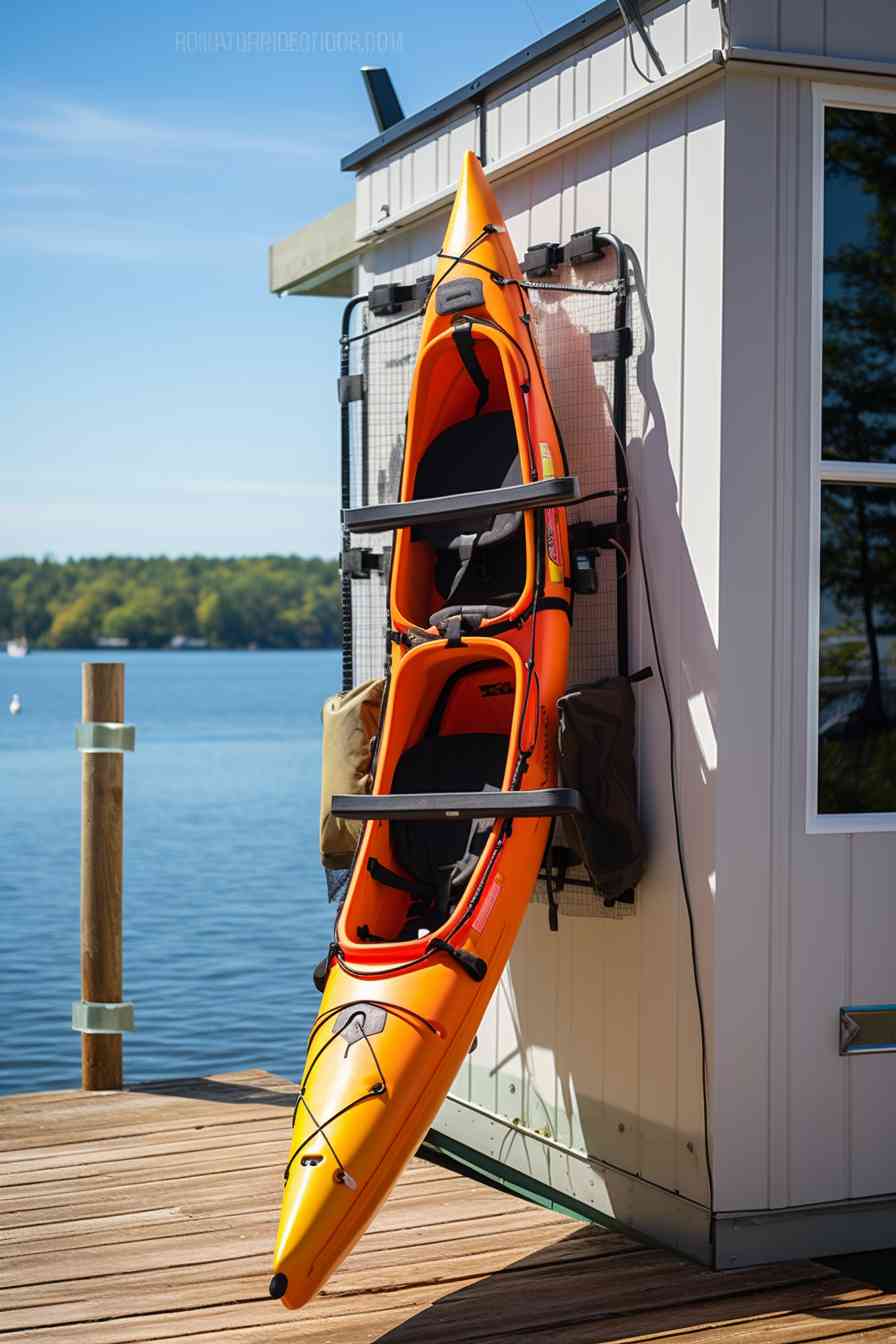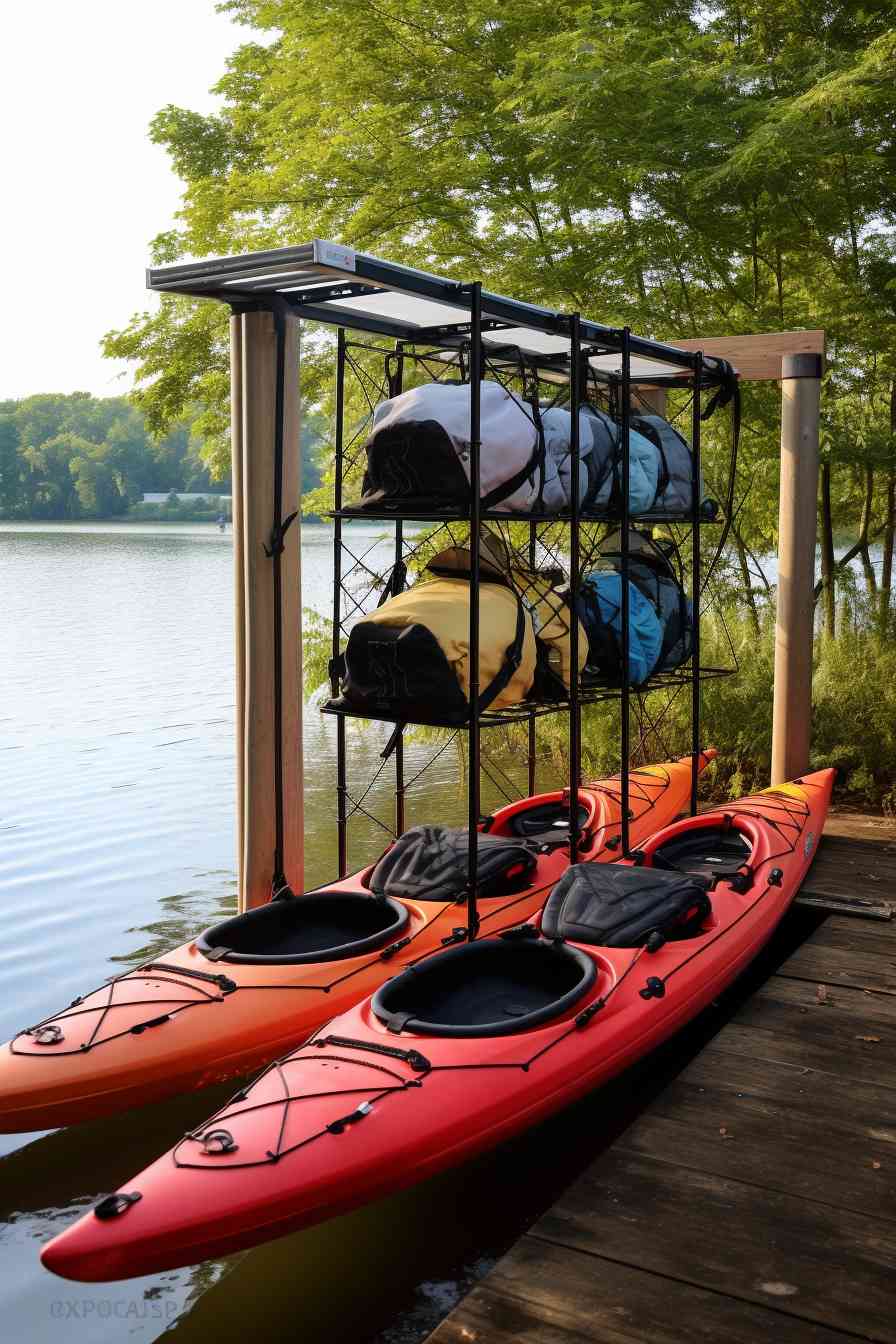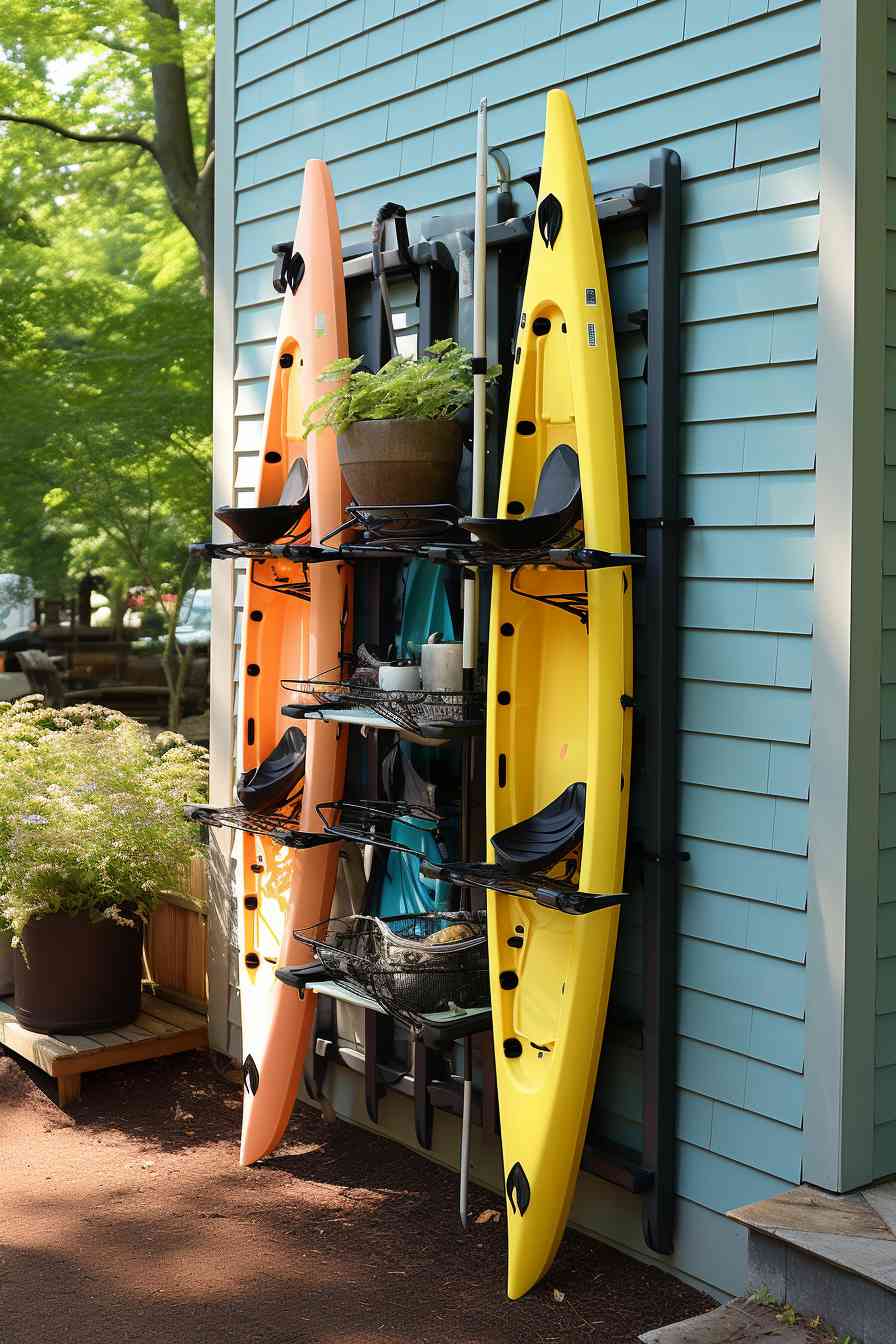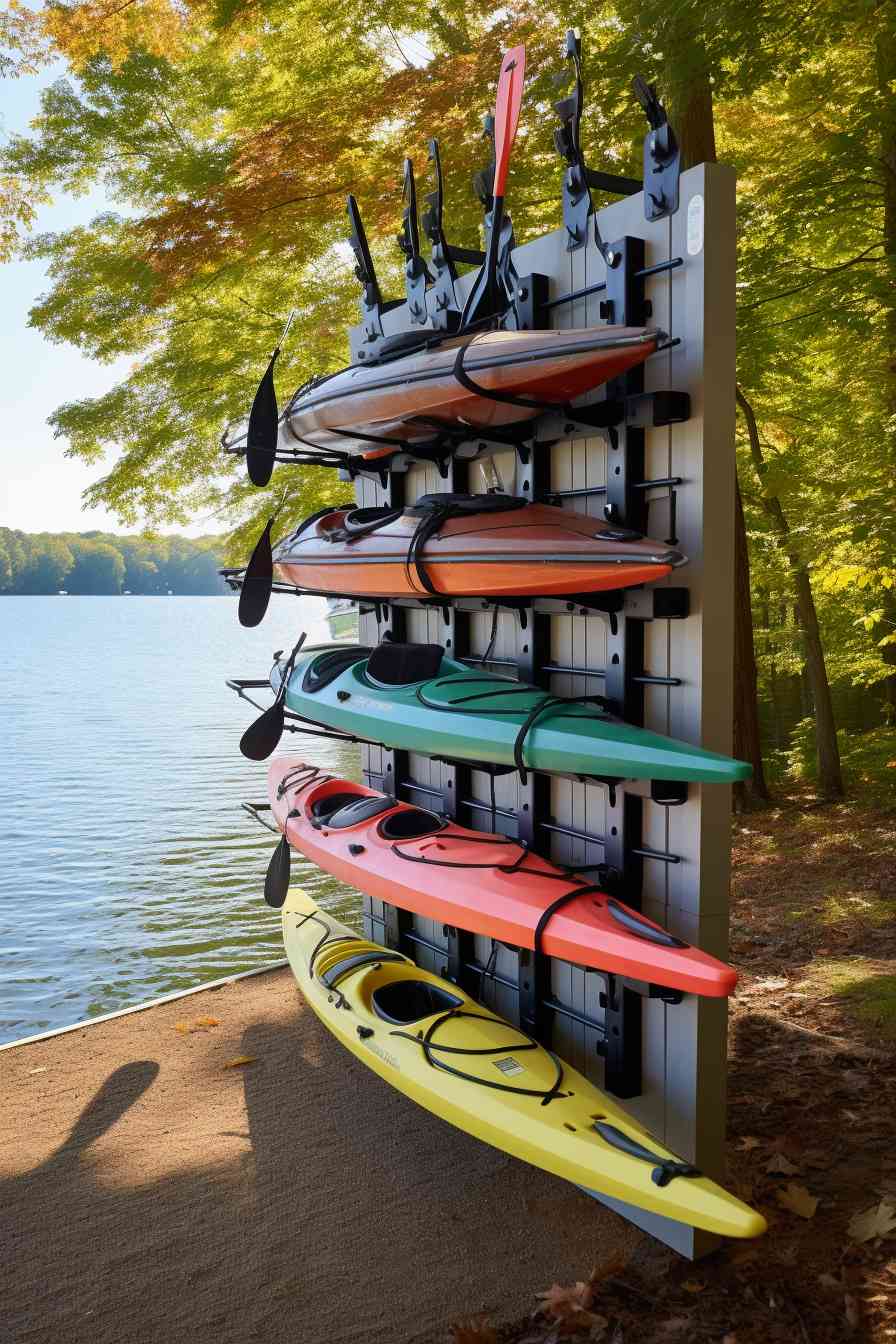Intro: How To Store Kayaks Outside

Well, hello there! Just another day in paradise, right? It seems like y’all have got a thing for kayaking, good on ya! It’s a marvelous sport, gets you outside, surrounded by nature, and all. But storing the darn thing, an absolute nuisance I say! Let’s roll up our sleeves and get into the heart of it.
Storing a kayak outside is not as simple as leaving it be in your backyard. Trust me, I’ve learned it the hard way. You gotta respect the elements my friend, sun, rain, wind, you name it. So, what’s the solution you ask? It ain’t rocket science, really. But needs to be done right, and I’m here to help.
Now, picture this. Your first line of defense is definitely a good cover. Nothing too fancy, but tough enough to shield it from the elements. Durable, water-resistant, fits the kayak well, that’s what we’re aiming for. A tarp will also suffice if you can tighten it securely.
Next, you need to consider the place where you’re gonna store it. You’ll want to avoid direct sunlight and any low-hanging branches. The shadowy side of a shed or fence works well. For added protection, try to elevate the kayak off the ground. This’ll reduce the chances of it getting damaged from bottom-up.
Now, an essential tip, always, and I mean always, store it upside down! You don’t want your kayak collecting rainwater or turning into a home for creepy crawlers, do ya?
Believe me, these small steps will add a few years to your kayak’s lifespan. Clean the boat before storing it up and check on it periodically, especially after a storm. And before you know it, you’ll become an expert yourself! Happy kayaking, folks! Remember, safety and maintenance first!
Is It Ok To Store A Kayak Outside?

Well, let me tell you, as an avid kayaker, this is a topic that’s near and dear to my heart. With that being said, is it okay to store a kayak outside? To keep it short and sweet, yes – but with a sprinkle of caution.
Now, don’t get me wrong, I’m not saying you can just prop it against your garden shed and forget about it. Nope, there’s a bit more to it. It would be best if you safeguarded your precious kayak from sun damage, snow, rain, and drastic temperature variations. These elements, especially the notorious UV rays, are a kayak’s worst enemy. They could compromise the kayak’s integrity— making it brittle and prone to breakage over time.
Investing in a high-quality kayak cover is one sure-fire way to keep your kayak in tip-top shape while it’s outdoors. These covers offer protection not only from the sunny old sun but from those pesky critters who might find your kayak an appealing place to set up shop.
Speaking of setting up, it’s also crucial to store the kayak off the ground. You can use racks or cradles designed for this purpose. They help distribute the kayak’s weight evenly, preventing the hull from deforming under sustained pressure. It’s also a clever idea to rotate the kayak now and then if it must stay outdoor for a sustainable amount of time.
In a nutshell, you can store your kayak outdoors, but it needs a dash of TLC to remain in great paddling condition. And always remember, a well-cared-for kayak means plenty of enjoyable outings on the water!
How To Store Kayaks Outside Long Term
Well, storing kayaks outside for extended periods can be a bit of a challenge, but it’s certainly not impossible. Here are some handy tips to guide you through!
-
Covered Area: When you’re thinking about keeping your kayak outside for a long time, try to find a covered space, like under a canopy or a shed. This prevents direct sunlight and harsh weather elements, which can cause deterioration.
-
Proper Racks: Invest in a good quality kayak rack. Kayaks should ideally be stored on their sides or upside-down to avoid warping or hull damage. Make sure the rack is sturdy, so your kayak isn’t going anywhere even in strong winds.
-
Use a Kayak Cover: Using a top-notch waterproof cover is a prime choice. It adds another layer of protection from weather damage, bugs, and critters. Make sure it fits snugly so it can’t blow off in a storm.
-
Off The Ground: Avoid direct contact with the ground, as that can encourage moisture build up and potentially damage or weaken the kayak. Straps, stands or wall-mounts are some options.
-
Clean Before Storing: Thoroughly clean your kayak before putting it away. Dirt, grime, or salt water can corrode the kayak over time.
-
Use a Security Cable: Thieves love easy targets. A locked security cable can deter potential theft. It might seem a trivial thing, but it could save you a whole lot of heartache.
-
Regular Maintenance: Do frequent checks on your kayak. Look for cracks, worn areas or any other signs of damage. This allows early detection and prevents minor issues from becoming significant problems.
-
Rotate the Kayak: If you’re storing the kayak for a very long time, try to rotate it every few months. This helps prevent warping or flat spots from developing.
-
Lubricate All Metal Parts: Metal parts can suffer from rust and corrosion when exposed to the elements. It’s a good idea to lubricate them before storing.
-
Deflate Inflatable kayaks: If you have an inflatable kayak, deflate it before storing. This will prolong its life and prevent any accidental damage.
Storing a kayak outside long term can seem intimidating, but with these steps, it needn’t be a chore. You’ll keep your kayak in tip-top shape and safeguard it against any untimely wear and tear. Just remember that minimal effort now saves a lot of effort and expense down the line. Happy kayaking, everyone!
Is It Better To Store A Kayak Vertically Or Horizontally?

First off, let’s tackle the question – is it better to store a kayak vertically or horizontally? Now, this is a query I get from many of my outdoor enthusiastic buddies. The answer is a little bit complex than a simple “yes” or “no”.
Between storing your kayak vertically or horizontally, there are pros and cons for each. Vertically, you’re looking at a compact and space-efficient method. But here’s the catch – it can cause deformity if not done properly. Due to gravity, the weight can stress the kayak’s hull and deform its shape over time. Now, that’s definitely not what you’d want, right?
On the flip side, horizontally storing be it on a rack or on its side, spreads the weight more evenly. It’s generally the safer bet for your beloved kayak’s longevity. Drawback? It gobbles up space which might not be a luxury for everyone.
So, each method has its ups and downs. What you need to do is weigh up the benefits and drawbacks and see which method fits your needs and circumstances best. Remember, the prime goal is to keep your kayak safe from any form of harm – be it UV light, harsh weather or gravity-induced deformity.
By the by, regardless of the method you choose, do ensure to cover your kayak properly to protect it from the elements. That, my friend, is your safety net!
How To Store Kayaks Outside For Winter
Alright, let’s talk about those practical steps to store your kayak outside during winter. It’s essential to take good care of our sporting equipment, especially when it comes to weather conditions as harsh as winter. Trust me, I know the feeling of discovering a damaged kayak after a long cold season– it’s heartbreaking and costly.
- Cover your kayak: First off, the simplest thing you can do is get a specifically designed kayak cover. This cover should be durable enough to pare the severe cold, snow and ice. It functions like a winter coat, keepin’ your kayak safe from those chilly winter elements.
- Store kayak off the ground: One of the best ways to store your kayak is to keep it off the ground. This might sound a bit weird, but it’s quite straightforward – you can use stands or racks to elevate your kayak. It helps prevent moisture from getting into your kayak, which in turn, reduces the chances of any kind of damage. This also keeps your gear away from any pesky rodents that might give it a gnaw.
- Clean and dry before storage: Before you shove your kayak away for the winter, give it a good ol’ clean. It’s really crucial to make sure your kayak is spick and span and thoroughly dry before you store it. This can prevent the buildup of mold and mildew, which can cause nasty damage over the winter months.
- Storing upside down: It’s a fact, storing your kayak upside down can help prevent snow or rainwater from collecting in the cockpit. Just think of it as an umbrella, deflecting water away from important parts.
- Apply UV protectant: You might not think the sun is a threat in winter. But let me tell ya, even on those short winter days, UV radiation can still cause damage. So, definitely consider applying a UV protectant to your kayak before putting it to rest.
Lastly, check on your kayak from time to time during winter. This doesn’t mean you have to babysit it, just a quick check-up to clear off any snow or ice. Remember, a stitch in time saves nine. So, with these tips in mind, you’re all set to keep your kayak in tip-top shape during that frightful winter season!
How Do You Store Kayaks Over Winter?

Well, storing kayaks over winter can be quite a task! I tell ya, you need a strategic plan to keep your kayak in good shape. The first thing to consider is cleaning the kayak. The last thing you want is salt, mud, or any residue hanging on your dear vessel throughout the frigid season. So, give it a scrub—inside out—and ensure it’s as dry as a bone before tucking it away.
I find it handy to apply a layer of aerospace protectant to my kayak. This stuff is pretty magical – it blocks harmful UV rays and wards off cracking or fading. Remember, kayaks, like us, can suffer from a lack of sunscreen!
Now, on to the point of storage! What’s the best way to store it? Well, ideally, you want your kayak to be off the ground. You can use a rack or hoist system – these are the bee’s knees for making sure your kayak doesn’t warp! If you mount it on a wall, strap it down tightly, but not too tightly. You’ll want to avoid squishing it – it’s not a pancake after all!
Let’s talk about the direction. The most common method is storing it on its side or upside down. If you’re leaning towards the upside-down method, ensure it’s not resting on its hull. The side of the cockpit or on the bow or stern is the right spot.
Lastly, you’ll want to cover it up. I’m a fan of specialized kayak covers– they’re waterproof and UV resistant. But, a sturdy tarp will also do the job.
And voila! That’s how you stored kayaks for the winter. Keep in mind the key is to keep it clean, covered, and off the ground. It might seem like a fuss, but trust me, come spring, you’ll see the difference. It’s worth every ounce of effort!
How Do You Winterize A Kayak?
Well, I’m sure we can agree that if you’re a fan of kayaking like me, you’d want to take good care of your kayak. Winterizing your kayak is a pretty important step, don’t you think? Is it tough you ask? Nah, it’s easier than you’d reckon!
First off, you gotta give your trusty kayak a good clean up. We hardcore kayakers aren’t afraid to get our hands dirty, now are we? Fetch a mild soap and a soft sponge and get scrubbing. Rinse well, chap! You wouldn’t want soap residue damaging your kayak down the line, would you?
What’s next on the list, you ask? Thoroughly drying your kayak, that’s what. Trust me, water isn’t your kayak’s best friend during those colder months. Excess moisture can freeze and damage your precious kayak. So, dry it inside-out using a clean rag or let it air-dry.
Finally, remember to apply a UV protectant spray to your kayak’s hull. Most kayakers I know skimp out on this step, but I always fume at their negligence. After all, the UV rays don’t care if it’s winter or not; they can fade and crack your kayak’s hull nonetheless. A protectant spray shields your kayak and extends its longevity.
How shall we store it, though? Well, ideally, find some indoor space. But if you must leave it outside, be mindful of how you position your kayak. Store it upside-down to avoid water pooling and snow build-up. A cockpit cover can be handy to keep critters and unwanted elements out. Elevate it off the ground using kayak stands or sawhorses, and cover it with a tarp or a specially designed kayak cover to guard against the elements.
Remember, each kayak is an adventure waiting to happen. Take the time to winterize it properly, and it’ll return the favor with memorable trips down the river. How about that?
Final Verdict
Well folks, rolling the curtains down and putting a wrap on everything. I tell you, if I had a dollar for every time someone asked me how to store their kayaks outside, I would have quite a stack! It’s understandable, really. Kayaks take up space, they’re a bit cumbersome to move about, and let’s not even start on the stress of worrying about them being damaged or stolen.
Now remember, securely storing your kayak outside mainly involves proper positioning, protective measures, and diligent maintenance. Always lay them down flat or store them on their side, never on the hull, to prevent distortion. And goodness, don’t neglect to cover it properly! Use a heavy-duty, specially designed kayak cover, against the dust, rain, snow, or harsh sunlight. But still, it’s worth checking every so often to make sure nothing’s gone awry.
The importance of a good lock cannot be overstated, and neither can regular cleaning. It’s imperative! Get on top of dirt, grime – they’ll degrade the material over time. Use mild soap and water, avoiding harsh chemicals that could damage the kayak’s surface.
In the end, the key here is vigilance. Keep an eye out, take good care, and your kayak will thank you! The outdoors, believe it or not, can be a safe, convenient storage space if approached correctly. So, don’t overthink it, just keep these tips in mind and you’ll do just fine. That’s my final verdict, dear paddlers. Keep making a splash and safe kayaking!
Frequently Asked Questions
How can I store my kayak outside during summer?
Summers are fine for storing your kayak outside. Keep it in a shaded area and cover it against harmful UV rays. If possible, consider a specialized kayak cover or tarp to do the job. But remember, don’t strap the cover too tight; it may deform the material over time.
What precautions should I take while storing kayaks outside in winter?
For winter, you have to be extra careful. Protect your kayak from snow and freezing temperatures, which can cause your kayak to crack. If you must store it outside, try to keep it off the ground and use a weather-resistant cover.
How to properly cover a kayak for outdoor storage?
A proper kayak cover that is weather-resistant and UV-protected is ideal. The cover should fit snugly but not ultra-tight. Don’t forget to ensure accurate ventilation to prevent mildew build-up.
Can I just leave my kayak on the lawn?
I wouldn’t advise it. Leaving it directly on the lawn can make it susceptible to dampness, pests, and damage from sun exposure. Always aim to keep it off the ground if possible.
Is it crucial to store a kayak upside down?
Yes, it’s crucial. Storing your kayak upside down helps prevent deformation of the hull. It also helps avoid water accumulation if it rains or snows.
Can I hang my kayak outside?
Indeed, hanging your kayak is an excellent outdoor storage option. Ensure the straps are wide and padded to avoid any pressure points that might deform your kayak over time.
What’s the safest way to store my kayak outside?
Safest would be to store it off the ground, upside down, covered and in a shaded or sheltered area. This reduces the risk of damage from UV rays, harsh weather, and pests.
Should I lock my kayak while it’s stored outside?
If theft is a concern, then absolutely! Locking your kayak might deter potential thieves. Many kayaks have places where you can secure a cable or chain.
Can I store my kayak on a rack outside?
Yep, storing it on a rack is ideal. Just make sure that the kayak is strapped securely, and the rack is sturdy enough to handle the weight and the elements.
Can I store my kayak leaning against a wall?
Yes, but make sure it’s leaning at a slight angle and not fully vertical. Also, ensure it’s well-secured so it won’t fall and possibly get damaged.

